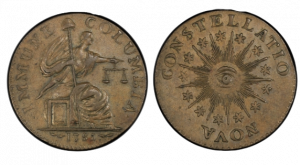How One of the Immune Columbia Coins Helped Build a Nation
Posted onRobert Morris might be one of the most important historical figures you’ve never heard of.

As one of the Founding Fathers of the United States, he was unanimously elected the first Superintendent of Finance in 1781. Shortly after his election Congress passed a resolution that approved the establishment of a mint. It was a critical step in becoming an independent country.
His work eventually led to one of the most fascinating Immune Columbia pieces, called the Nova Constellatio, which was one of the first coins struck under the authority of the U.S.
The coins were part of Morris’ plan to develop a simple system that would allow for the easy conversion of Portuguese, Spanish, British, or State currencies to U.S. money. Morris’s idea however, was more than practical, it was also innovative. He devised a type of coinage that used decimal accounting – a system based on units of 10 – which was eventually adopted by all other nations. In time, Morris gained powerful support from Alexander Hamilton and Thomas Jefferson.
Morris called for the creation of a gold piece equal to ten U.S. dollars, a silver dollar, a tenth of a dollar in silver, and a hundredth of a dollar in copper. This initiative led to the striking of the Nova Constellatio coins in 1783. The name – a new constellation- evokes images of a group of diverse people united in one nation.
This was just one of Morris’s many contributions to the success of the U.S. He is also credited with establishing the first congressionally chartered national bank – the Bank of North America – to operate in the U.S. He is widely credited with financing the Revolutionary War given his success in redirecting government funds to purchase supplies needed to fight the British. In fact, many of these supplies ultimately went to the Continental Army under General George Washington. The resources helped him win the pivotal victory at the Battle of Yorktown.
Today, five patterns of the coin exist. In silver denominations, the range of values is 1,000 units, 500 units, 100 units, and 5 units. The 500-Unit family consists of two pattern types. One side, with the all-seeing eye and rays of light, consists of 13 stars representing each state at the time. The reverse shows a laurel wreath with “Libertas Justitia” meaning “Liberty, Justice.”
Unfortunately, Morris’ plans never came to be and the currency didn’t advance beyond the Congressional committee. More than a decade passed before the first official United States Mint even opened. The few of these very rare coins that exist can be traced back to Morris himself and Charles Benjamin Dudley, a chemist, and metallurgist who was assaying various metals at the time.
The coins are a rare look at what could have been in the early days of the U.S. and a fledgling currency. Even if the coins never became part of the financial system, the innovation behind them – decimal accounting – certainly did.
Want to read more? Subscribe to the Blanchard Newsletter and get our tales from the vault, our favorite stories from around the world, and the latest tangible assets news delivered to your inbox weekly.







